If you click a picture it will be enlarged. The pictures can then be viewed in succession as a slideshow. If you see a link, for example: Rama Tours , click on the link and it will be opened. When referring to a map, the map can be accessed by clicking on the link : map of Indonesia. The clips (images with an arrow) that are included are HD recordings. The clips can be viewed in a separate window that automatically opens when you click on the image with the arrow.
English is not our native language, so we apologize in advance for translation- spelling- and grammar errors.
We are on time at breakfast. At 8.30 am. we are picked up at the hotel for the ride to the airport. We leave our big suitcases behind in the hotel. At 10.40 am. the plane takes off. In less than an hour we land at the airport of Wamena (see map) The landscape around us colours very green here.
To be allowed to visit the Baliem Valley(see map) you need a special permit. At the airport therefore we first have to visit the authorities for a stamp on our visa for this valley. All our papers are in order. Our guide and car are waiting for us. It is only but a short drive to hotel Pilamo. In front of the hotel is an old man dressed with only a traditional penis sheath (Koteka). Rufus, our guide warns us, the men in front of a hotel ask extreme prices for their souvenirs and a picture. We had already figured that out a bit. There will be enough beautiful authentic photo moments in the coming days so we only greet the old man and enter the hotel.
At 01.00 pm. we would have a ride with a Becak, a single rickshaw, through the city. But it's an Islamic special day today and therefore Rufus could not find the right drivers who could take us for the ride. So we will make a tour by car instead.
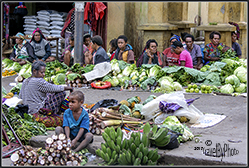
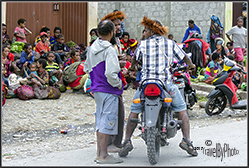
We stop at a small market. Many local people out there. They look colourful. Almost all wear their own crochet bag. The facial expression of the people however doesn't look joyful at all, we think it looks more rather grumpy. But that might be just our imagination. We look around and after our visit go to a coffee plantation.
That is not a very exciting visit. It is not a working place but a assembly place. There is only a cooperative barn that serves as gathering place for the harvest of coffee beans. The smal farmers from miles around bring it here in big jute bags.
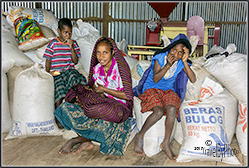
There are 3 girls. One of them has a beautiful crochet bag on her back. There appears to be a 2-month-old baby in. Babies and all kind of goods are carried in these strong bags. They are worn with the handle as a band over the head.
We make a walk through the fields. The air is dark but it remains dry.
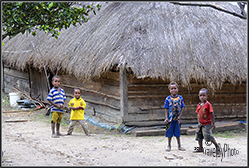
After a nice walk we return to the car. We finish our day trip with a second visit to a market.
Women sell very small servings of vegetables such as cauliflower, roots, tubers, sweet potatoes, tangerines.
We walk around and Ingrid buys a strong crochet bag by a women who hooks her own bags. Nice to have it bought directly from the woman who makes it. All the women are crocheting, even when they walk. Sometimes with a real crochet hook, sometimes only with a small twig.
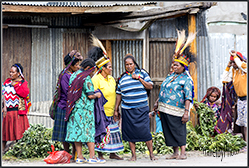
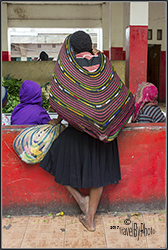
After our visit to the market we go back to our hotel. From here, we walk to a supermarket. Very special to pay the groceries in the supermarket next to a naked man that only wears a traditional penis sheath and also just had done some quick shopping in the supermarket.
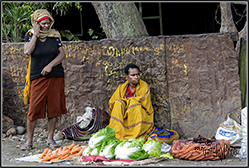
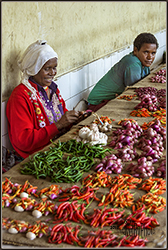
At the end of the afternoon it starts to rain a bit. We do not mind it.
Tomorrow is another day and for now we have dinner at the hotel. It was very tastefull. The evenings in Wamena are considerably fresher than on the coast. Not so strange; Wamena is at a much higher altitude. There are some mosquitoes and we know that they are fond of Ingrid's blood so it's good to rub again with DEET here out of precaution.
The breakfast is good. In addition to an extensive Indonesian breakfast, a Western breakfast with different types of bread to roast, jam, butter, yoghurt, fruit and on request an omelet.
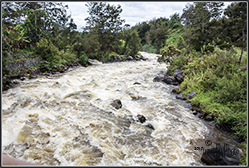
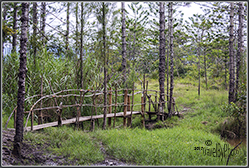
At 9 am. we leave from the hotel for a nice trekking through the valley.
We are brought by car to the starting point of the hike. The walk has steep slopes, but is especially difficult due to the wet slippery paths we walk over. Pigs run loose. They have a lot of space and a good live here. You would like the living conditions of pigs in the Netherlands to be the same. Rooting in the mud and the pee.
Occasionally we see traditional huts that are still in use as a residence, but we also see a lot modernized stone houses. Here too, modern times slowly but surely make its entry
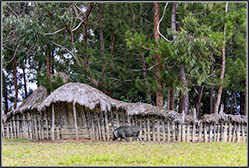
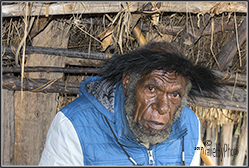
We meet people who are on their way to the fields and watch the children playing. Women with those beautiful large characteristic bags carrying huge loads.
Eventually we climb through the jungle to a waterfall. That is very slippery! It rains here virtually every day, so always mud.
At the waterfall is a group of yong gils and boys who have a kind of Bible group in nature. There is a woman who gives them lectures from the bible with a i-pad and they pray and sing together. A strange encounter in the middle of the jungle.
We wade through the waters of the river and glide over the muddy paths in the forest.
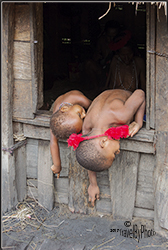
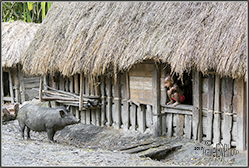
After lunch we walk further through the Valley. We walk to a Dani village. On narrow trails and over rickety wooden walking bridges - made clear for only local traffic here - we find our way and cross the river.
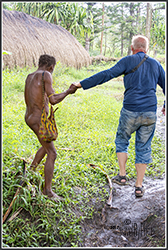
The villages of the Dani have an entrance with a door in a fence of branches. Above the entrance is a large roof fixed in the form of a Crescent Moon with both points to the ground.
The Dani have their gated villages to protect themselves from intruders from other tribes. Dani houses are characterized by the fact that the men's houses have a round shape. The women's houses are elongated. The children sleep in the women's houses.
Married Dani's don't sleep together. The men sleep together in one House and so do the women. On the houses is a thick thatch roof. Cane plants such as papyrus grow plenty of in the Baliem valley. Because the roof is so thick it remains nice and cool indoors while outside it is over 30 degrees.
In addition, there are hutches for the pigs (although they always run free during the day) and a cooking hut.
Only one family lives in such a village. Different generations: (Grand) parents, children and grandchildren together.
Unfortunately, it starts to rain just as we reach the village. Many villagers are not at home. They work on the fields, but there are two older men left in the village. Rufus can translate so it is possible for us to chat with the men. We present them a few Kretek cigarettes. Kretek cigarettes are Indonesian cigarettes with cloves in it. We always have some with us to hand out. The men spred out some merchandise on a table. Several Koteka, chains, bags. They ask quite high prices. We buy nothing.
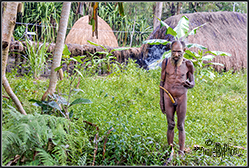
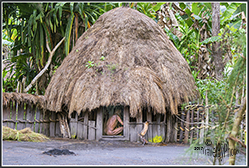
We take shelter with the men against the rain.
Through the gate of the village, an old man walks to us to meet us. He is from the neighbouring village. Grandpa is just dressed with a Koteka. He is a very nice person.
The moment it gets dryer we walk with him to his village. The old man moves smoothly over the pits, streams and trellises and puts out a helping hand to Jan-Arend.
A very special encounter. We admire his village and are invited in the cooking hut. Our host picks up a few clearly-used-penis sleeves from his hut and these turn out to be reasonably priced so we we buy a few from him.
A penis sleeve, holim (Dani) is usually made of a bottle gourd, which is forced in the desired model during growth. Gourds grow along the edges of cabins and garden gates in the villages. The gourds are sometimes a little decorated with wires and feathers. The penis sleeve is usually pointing up; a rope around the middle keeps the tube in position. This is undoubtedly with the intention to portray a permanent erection. A penis sleeve is therefore rather an accent lighting than a covering of the noble parts! At the bottom the penis sleeve is tied to the scrotum with a piece of string.
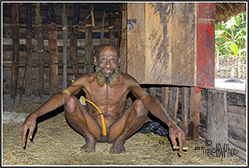
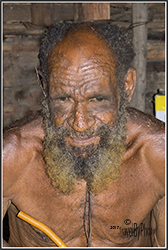
Young men who have to perform a lot of physical work, prefer a short penis sleeve with a wide opening at the top. The upper part of the sleeve is sometimes used as storage space. Papuans in the Baliem valley use it for example to storage a red cloth. A red cloth is worn around the waist as a decoration by ceremonies.The penis sleeves do not annoy with daily work.
This is really a very special visit and to a huge merry cordial host. Later, 2 grandchildren enter the hut. Very cosy. Jan-Arend films. Everyone must laugh as the recordings are played back.
It is dry again. We take some more pictures of our host. and are said farewell by calling out "Wa, wa, wa, wa, wa."
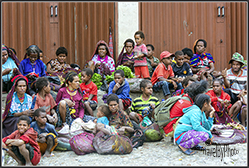
It is still a long walk before we arrive at the place where we will be picked up by the car. The car is already there when we arrive and we drive back to Wamema.
In Wamema we stop again at the market where we get off. We never can get enough of it. We find markets always so nice, but the people here often look very acidic so whether they also like our visit too. ....? We are regarded more as intruders so it seems. Sometimes if you say Hi to them you get some friendly interaction, but not a really very friendly atmosphere here.
However, there are lots of things to see on this large market. We see women with gorgeous feather ornaments on their head, merchants with carrots, betel nuts, tobacco paste, vegetables, fruit, and of course the bags that the women make and use themselves. There are also chicken and even rabbits for sale on the market and of course fish.
Suddenly there is panic on the market. A huge uproar. Everywhere runaway people. Rufus says there is a riot going on. Maybe caused by an argument or drunk people? It can become dangerous so we are urgently advised to leave. So we do. Dropped by the grocery store we buy some snacks, have diner in the hotel and relax. Tomorrow is yet again a new trekking by foot on the program.
At 9 am we leave by car from the hotel. There are many people along the way. They are waiting for a 4 wheel drive that can give them a ride. No hitchhiking, but a kind of public transport. Quite common here. We start today a trekking of 2 days through the Valley.
The Baliem valley is 72 kilometers long and varies in width from 16 to 32 kilometers. The Valley is surrounded by peaks of 2,500 to 3,000 meters altitude and thanks its name to the Baliem river that flows through the valley.
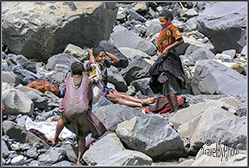
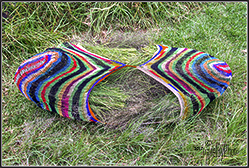
After less than an hour drive we are at the starting point of our hike. As stated in our travel description Rufus and a young woman to wear our stuff will accompany us. We don't feel easy to see the young woman carrying our luggage even though we have but little luggage taken, but she seems to carry the load, with the greatest of ease.
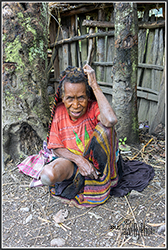
The women wear really heavy loads here. Vegetables, sweet potatoes but also babies. All and everything in the home-made bags they carry over the head.
The scenery through the mountains where we walk through it is quite nice. Many villages surrounded by the artfully braided hedges. We regularly come across yet another beautiful man with only a penis sleeve, who just walks along the road or works in the fields together with his wife.
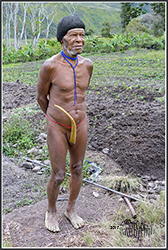
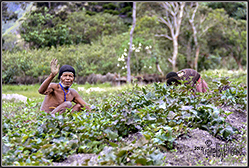
We need to cross the river. Shoes out and barefoot through the flow. The flow is powerful. On their barefoot they go with their heavy goods through mud and water. Slipping? Slippery yes, but the people here are so handy. Without fear of falling they cross deftly.
Around us are people that work on the fields. The walk appears to be fairly short. After just a little more than an hour we are - to our surprisethere - already at our destination! We arrive at the home stay. The home stay is part of a school for girls.
They give here girls from the surrounding villages basic education. We have a good bedroom with 2 beds and a dining room. Outside on the veranda is a sofa under a awning.
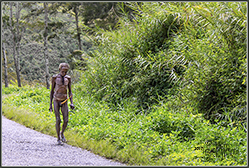
Well, it's still early, barely 11 am. We get lunch. We are still full of energy. Therefore we ask Rufus if it is possible to make an extra walk in the surroundings in the afternoon.
Fortunately that is possible. And so we go on the road again. On a very steep path we descend into the valley and then up again to the mountain beside us. We saw from out of the Home stay in the far distance a village with huts and now we are going to visit that village.
We meet different people. One man comes just from the field with a bucket filled with sweet potatoes, an important crop here. Another comes smiling toward us escorted by a few pigs. Wa wa wa wa it sounds at every greeting.
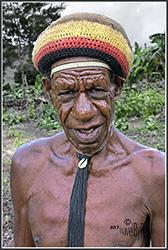
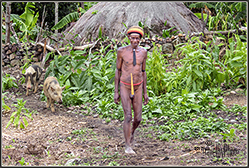
The shacks are everywhere more or less the same. They are not big.
It feels so good to be here and walk around in such a originally settlement where not much has changed. They even have no electricity here yet. All around us pigs. Large, but also very small. The men are very sinewy. Low fat, high fiber muscles.
It is an adventurous walk!
At the home stay we have a good diner. After diner there is nothing to do here. It's dark and there's no electricity. That is why we go flat at around 8 pm.
We did not sleep much tonight. The beds and pillows are very hard, and to the mattresses are covered with a layer of plastic so that it creaks by every movement you make! But, if you go to sleep so early you know that you won't sleep all night in once.
We therefore wake up early, eat breakfast with fried rice and at 8 am we leave from the home stay.
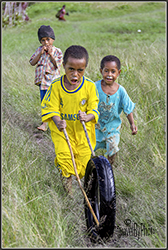 The walk today will be a lot longer and be more difficult then yesterday. Again first the steep path down to the valley, then across a suspension bridge across the river and then up the mountain on the other side of the river.
The walk today will be a lot longer and be more difficult then yesterday. Again first the steep path down to the valley, then across a suspension bridge across the river and then up the mountain on the other side of the river.
Many people who carry a lot of cargo are underway . Kids play with old car tires, something you see in almost every country outside Europe. Great fun while a lot of snot is comming out of their noses. We buy 2 extra homemade bags from women at the side of the path.
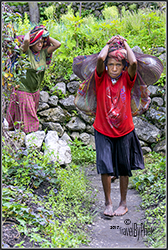
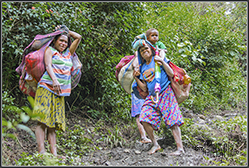
A large part of the route today is for us Westerners very heavy! The clay on the narrow winding mountain trails remains always wet and slippery.
The profile of our mountain shoes are already full of clay after a few steps and then it is further slithering walking trough and anxiously trying not to fall! Time and again, your feet are sliding away; no matter how careful you try to move.
The fields we come across are cultivated here with especially sweet potato.
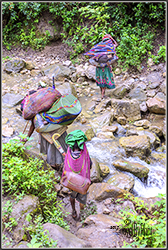
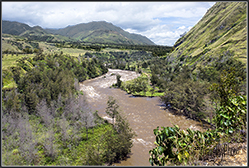
High in the hills we follow the flow of the river down in the valley. The river is very wide here and there, and also very wild. If you look at the stone bedding next to the river you can imagine how wide the river must be here in the rainy season! The water level then will be much higher!
After hours of walking, of which a large part mud flowing steep rise and fall, we arrive at the riverbed of the large swirling River again. We cross the river on a suspension bridge and not much later we are at the pickup point for the car that brings us back to our hotel.
Jan-Arend would like to find some local Papua music for the film. Somewhere in a store a young man is so kind to load a lot op Papua music on to a SD card. He don't even want to get paid for it. Very nice! We go to the supermarket and rest a little in the hotel. Many aircraft flying over here. Especially chessna's. Not so strange since this is an area where you only can come by airplane.
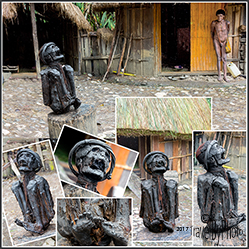
Today promises to become a very special day. One of the most impressive excursions that you can make in the Baliem valley is attending a pig-feast and that is exactly what is scheduled on our program for today. At 9 am we are picked up at the hotel.
The air is grayish. That is a pity. Hopefully it will not rain too much today.
First we visit Kampung Sompaima. In this Kampung a famous "black Mummy" is saved. The mummy is very special. Approximately 300 years old and petrified it seems.
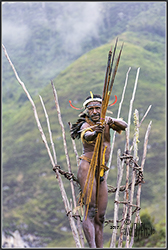 The mummy is not in sleeping position, but sits with bent knees, hands to the legs and head proudly raised. The mummy is of an important warlord who has been mummified for guarding and sustain the welfare of the family and society. Everything is still recognizable, even the penis sleeve.
The mummy is not in sleeping position, but sits with bent knees, hands to the legs and head proudly raised. The mummy is of an important warlord who has been mummified for guarding and sustain the welfare of the family and society. Everything is still recognizable, even the penis sleeve.
We are surprised. We thought that the mummy would be handled very sacral and respectful but that doesn't show! One of the men comes out of a hut with the mummy in his hands and asks: "where do you want him"? Where shall I put him? Special! Very different then we thought.
Rufus has warned us to be careful with taking pictures. Sometimes they ask a lot of money for it but not this time. Probably because the excursion is already paid for in advance. So we can take our pictures without being pushed for money.
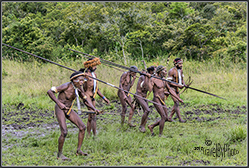
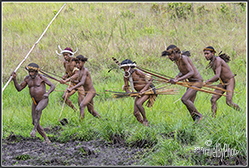
After our visit to Kampung Sompaima we wade ourselves through the mud to the adjacent village where the ceremonies and festivities of the pigs feast will be held. The villagers are notified in advance of our arrival and you buy a pig before arrival. That is done for us and the pig is already present in the village for when we come.
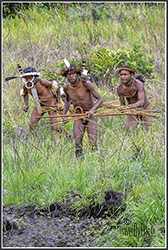
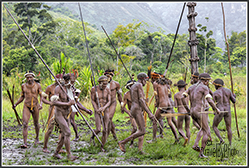
Before we reach the village we see a warrior in a watchtower.
He produces strident cautionary cries. The enemy is clearly signaled! From the forests appear ferocious-looking traditionally dressed Papua men.
They perform a (Sham) fight similar to the fight they held in the - not so far -past for real. The men are armed with spears and bow and arrow. The fight goes up and down. There is a warrior wounded. Very impressive to hear their cries! The fight ends with a round dance of all warriors around the watchtower
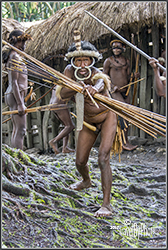
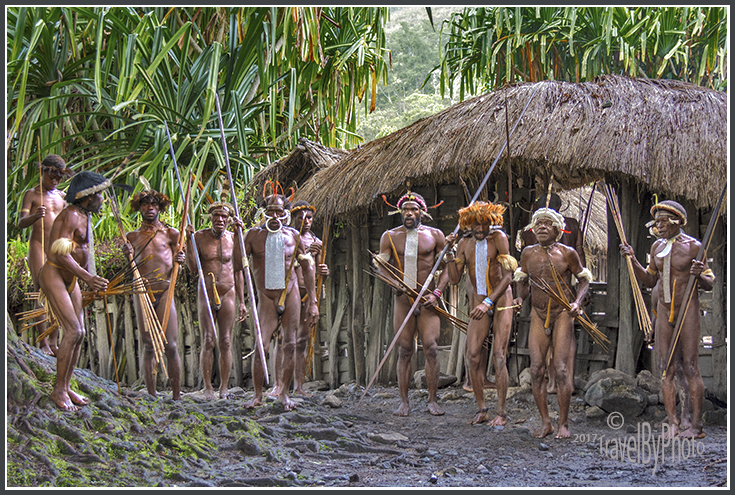
The warriors walk to the direction of the gate of the village. We are invited to follow them. We are the only two guests. The company of warriors stops in front of the entrance gate of the village and turn their faces forward us. We get welcomed with rhythmic cries and pounding dance steps. This first welcome ritual is overwhelmingly. Quite impressive to experience.
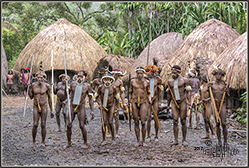
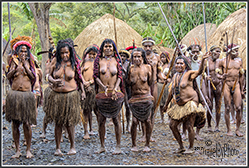
After the dancing in front of the port we are invited by the men to come through the gate and enter the village where the women in traditional clothing (grass skirt) are waiting for us.
What follows is a second welcome dance; but now by the men together with the women.
In this village, built according to ancient traditions, people still really live. Of course their outfits is updated on the arrival of guests. The women will not wear grass skirt anymore in daily life, but by and large, everything takes place according to how it was done in earlier times. Older men in the countryside after all, as we have seen, are still often dressed with only the penis sleeve attached to their body. The younger men don't do that anymore; they do that only at festivities to keep traditions alive. In this village the young men today wear a penis sleeve for the pig feast.
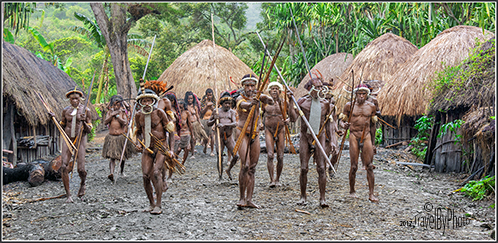
Nice that we can freely photograph and film. Unfortunately, it is a little bit raining. A sweet old lady (her name is Wilhelmina, she explains) wants Jan-Arend to take a photo from her with Ingrid. She shows Ingrid her hands; the first phalanx of 6 (!) fingers are cut off! Women in the past expressed their grief by cutting off a significant part of their finger.
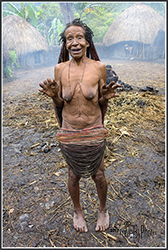
For the amputation the circulatory system is cut off with string to make them numb. Subsequently, the wound is cauterized. The ritual is done - as usual - to satisfy the gods. Today this ritual is officially forbidden. It is therefore rare nowadays but certainly not yet extinct!
Bizarre tradition of witch the woman are the victim!
Ingrid is also invited to dance with the women. She accepts the invitation. Why not? Cheerful.
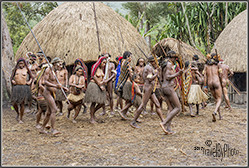
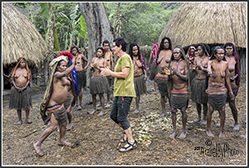
All though, during the dance the women make clear to Ingrid that her moves are a bit too unregulated, that she dances in the wrong place and with the wrong rhythm so she is gently led to follow their dance moves that still seem to be bound to certain strict rules.
Everyone is equally friendly for us. Not for the pig though that will be slaughtered! After all, we are on a pig party. The pig will be cooked and eaten! A small piggy is taken from his loft. He puts it on a run but there is no escape.
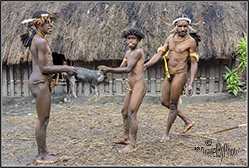
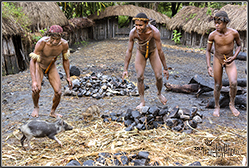
The men are chasing him and eventually catch him. This is the nasty part of the ceremony! The piggy is held by head and butt between two warriors. He is killed with arrow and bow. It takes quite a long time before he is dead. Not a pleasant sight. We are not used to it and are happy when it finally done!
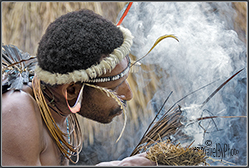
The men are busy to make a fire place.
Fire is made in a traditional way. With a fire-by-friction technique using a string. A branch is made to smolder. Once it smolders dry grass is brought to fire and taken to the fire place. Handsome; even in the rain they succeed to make the fire, but the wet wood smokes considerably. Other men are in the meantime dealing with preparing the dead pig. In the end the pig is put above the fire to wipe off the hairs.
Special to see how the older men learn the younger guys how prepare the pig in the proper way.
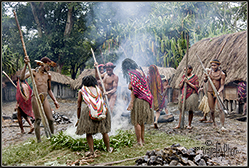
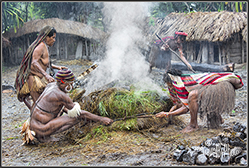
Large stones are place in the fire place. The process is as simple as it is ingenious. There is a large pit that is covered with leaves. The moment the stones are red hot warm they are put out of the fire. The villagers bring the hot stones in a joint action to the pit. They pick up the hot stones and transport them to the pit with long sticks that has a split at the end. All simple handwork, but so efficient!
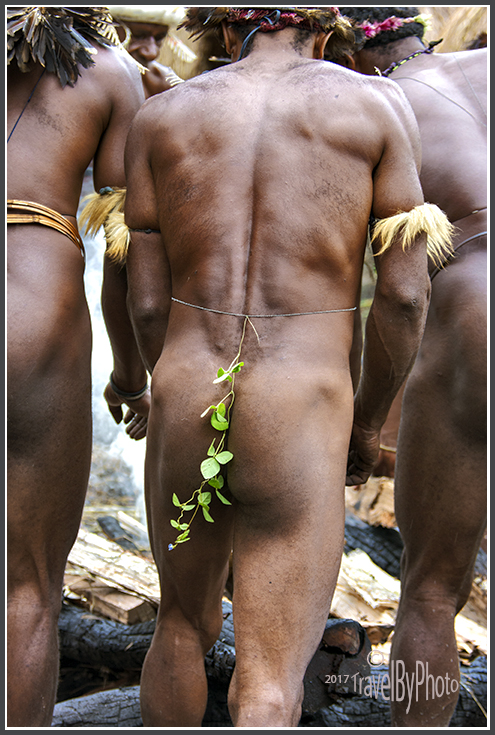
When that is done the pig together with vegetables and sweet potatoes is put on the hot stones. The pig is completely packed. The pit is then further poem with leaves, hay and straw. The whole is wrapped with ties. So it becomes a real oven in which the pig can simmer for an hour until the meat is tender.
Meanwhile, it is has started to rain heavily. Ingrid is invited in the women's house.
Jan-Arend goes with the children to the river bank where the innards of the pig are cleaned by the children.
In the women's house are the women and younger children. There are fires and the women sing and are busy with their crochet work; the bags. It is stuffy in the hut with all those fires and the smoke.
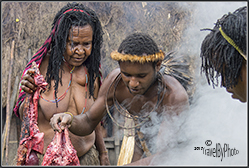 In addition, the women here also like to smoke a lot of cigarettes themselves! We have brought them with us as a gift. A kid, about 8 years old, also wants a cigarette. Ingrid refuses but that doesn't help; he gets a cigarette from his mother. You cannot imagine; a kid of 8 getting a cigarette from his mother!
In addition, the women here also like to smoke a lot of cigarettes themselves! We have brought them with us as a gift. A kid, about 8 years old, also wants a cigarette. Ingrid refuses but that doesn't help; he gets a cigarette from his mother. You cannot imagine; a kid of 8 getting a cigarette from his mother!
The men have their buttock seam often covered or more decorated with a pendulum of leaves or feathers. The children, as well as some women, have made impressive snotty balls that sometimes violently turn the nose in and out.
Ingrid shows on her phone some movies of our granddaughter Fenna to the women. The women find it great fun. The picture of son-in-law Bram with a huge carp in his hands also makes heavy impression!
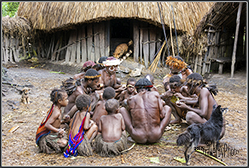 It's nice that we are the only 2 tourists here today. Yet very different if you go around here with a group . Now you it is much easier to make real contact. When Jan-Arend returns in the camp from the river he sits down in the men's hut and gets a cup of - something meant to be - coffee.
It's nice that we are the only 2 tourists here today. Yet very different if you go around here with a group . Now you it is much easier to make real contact. When Jan-Arend returns in the camp from the river he sits down in the men's hut and gets a cup of - something meant to be - coffee.

Then the piggy is ready. Together with the men we get the first piece of pork with roasted sweet potato . To be honest .... it tastes great. The meat is further divided. A group of men with young boys are sitting and eating together. They are surrounded by a few dogs on the hunt for the leftovers. The women form a separate group. They too clearly enjoy the food.
We take some more pictures. It is unfortunately going to rain harder. The pigs feast provides members of the Dani tribe the chance to earn something while their traditions remain alive. Of course, we know we are on a tourist excursion, but that's not really noticeable of and certainly not during the joint meal. Everyone is genuinely busy and it is clear that these people take pride in their origins and traditions, like to propagate these and like to hand them over to the next generation. Festivities like this benefits the entire community.
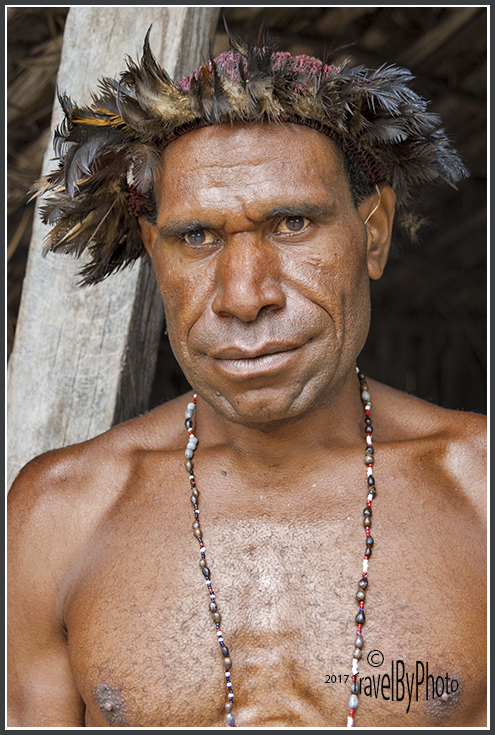
Before we return to the car the men and women create a little market place. They form a circle and present their home-made merchandise. Crochet bags, jewelry with bones and shells, penis sleeves. We buy a few things and then we go.
We are escorted to our car. Imagine, we sliding trough the mud In the forest, hand in hand with a naked man with his penis sleeve and under a umbrella held high by him. It must have been a funny sight. We arrive tired and a little cold In the hotel but it was a very unique day The hospitality that we have experienced of the Dani was very special and unforgettable.